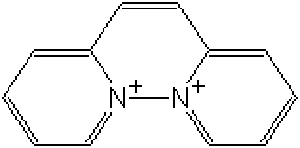Diquat
- 9,10-Dihydro-8a,10a-diazoniaphenanthrene
- 1,1'-Ethylene-2,2'-bipyridinium
- Diquat dication

Diquat | |
| |
| Formula | C12H12N2 |
| Structure |  |
| Description | Diquat is a yellow crystalline solid dissolved in a liquid carrier. |
| Uses | Herbicide. |
| Registry Numbers and Inventories. | |
| CAS | 2764-72-9 |
| EC (EINECS/ELINCS) | 220-433-0 |
| EC Index Number | 613-005-00-3 |
| RTECS | JM5685000 |
| RTECS class | Mutagen; Human Data |
| Beilstein/Gmelin | 3670526 |
| EPA OPP | 32202 |
| New Zealand | Listed |
| Japan ENCS (MITI) | Listed |
| Properties. | |
| Formula | C12H12N2 |
| Formula mass | 184.26 |
| Hazards and Protection. | |
| Storage | Keep in a cool, dry, dark location in a tightly sealed container or cylinder. Keep away from incompatible materials, ignition sources and untrained individuals. Secure and label area. Protect containers/cylinders from physical damage. |
| Handling | All chemicals should be considered hazardous. Avoid direct physical contact. Use appropriate, approved safety equipment. Untrained individuals should not handle this chemical or its container. Handling should occur in a chemical fume hood. |
| Protection | Chemical splash goggles in compliance with OSHA regulations are advised; however, OSHA regulations also permit other type safety glasses. Whre chemical resistant gloves. To prevent repeated or prolonged skin contact, wear impervious clothing and boots. |
| Respirators | Use NIOSH/MSHA approved respirator appropriate for exposure of concern. |
| Small spills/leaks | Keep material out of water sources and sewers. Build dikes to contain flow as necessary. Land spill: Dig a pit, pond, lagoon, holding area to contain liquid or solid material. Dike surface flow using soil, sand bags, foamed polyurethane, or foamed concrete. Absorb bulk liquid with fly ash or cement powder. Water spill: If dissolved, in region of 10 ppm or greater concentration, apply activated carbon at ten times the spilled amount. Use mechanical dredges or lifts to remove immobilized masses of pollutants and precipitates. |
| Stability | No data. |
| Fire. | ||||
| Fire fighting | Extinguish fire using agent suitable for type of surrounding fire. (Material itself does not burn or burns with difficulty.) | |||
| Hazards | Decomposes at high temperature, charring rather than melting or boiling. | |||
| Health. | |
| Exposure effects | |
| Ingestion | See inhalation. |
| Inhalation | INHALATION: No appreciable vapor pressure. Prolonged contact with spray or mist may cause oral and nasal irritation. EYES: Irritation. SKIN: Irritation. INGESTION: Vomiting, diarrhea, general malaise. Possible kidney and liver damage, dyspnea, and pulmonary edema. With large doses there may be tremors or convulsions. OTHER: May be fatal if swallowed, inhaled, or absorbed through skin. |
| Skin | See inhalation. |
| Eyes | See inhalation |
First aid | |
| Ingestion | DO NOT INDUCE VOMITING. If the victim is conscious and not convulsing, give 1 or 2 glasses of water to dilute the chemical and IMMEDIATELY call a hospital or poison control center. Be prepared to transport the victim to a hospital if advised by a physician. |
| Inhalation | IMMEDIATELY leave the contaminated area; take deep breaths of fresh air. If symptoms (such as wheezing, coughing, shortness of breath, or burning in the mouth, throat, or chest) develop, call a physician and be prepared to transport the victim to a hospital. Provide proper respiratory protection to rescuers entering an unknown atmosphere. Whenever possible, Self-Contained Breathing Apparatus (SCBA) should be used. |
| Skin | IMMEDIATELY flood affected skin with water while removing and isolating all contaminated clothing. Gently wash all affected skin areas thoroughly with soap and water. If symptoms such as redness or irritation develop, IMMEDIATELY call a physician and be prepared to transport the victim to a hospital for treatment. |
| Eyes | First check the victim for contact lenses and remove if present. Flush victim's eyes with water or normal saline solution for 20 to 30 minutes while simultaneously calling a hospital or poison control center. Do not put any ointments, oils, or medication in the victim's eyes without specific instructions from a physician. IMMEDIATELY transport the victim after flushing eyes to a hospital even if no symptoms (such as redness or irritation) develop. |
| Transport. | ||
| USCG CHRIS Code | DIQ | |
| Std. Transport # | 4963342 | |